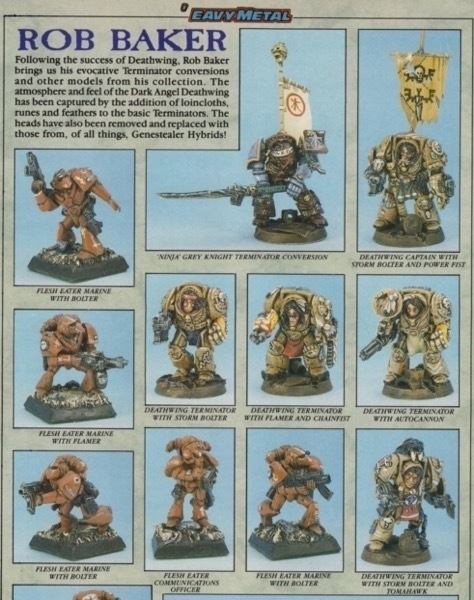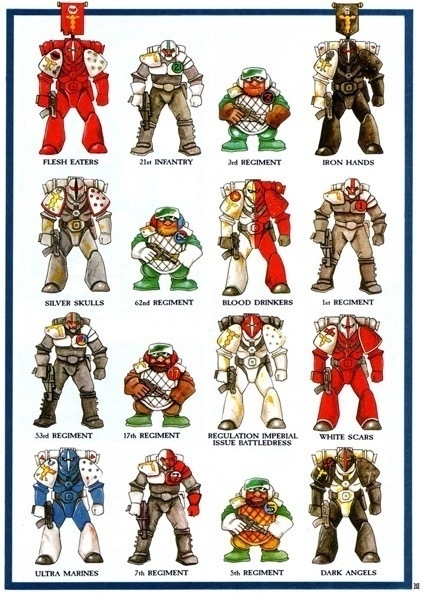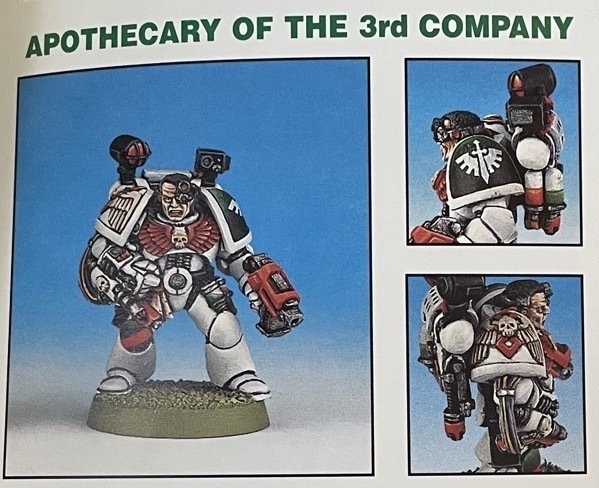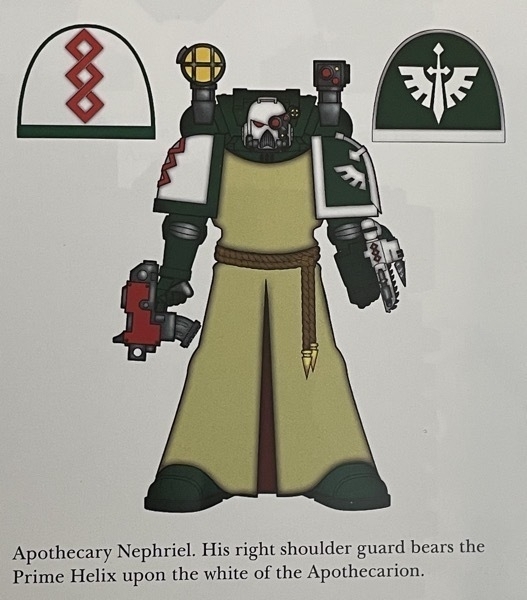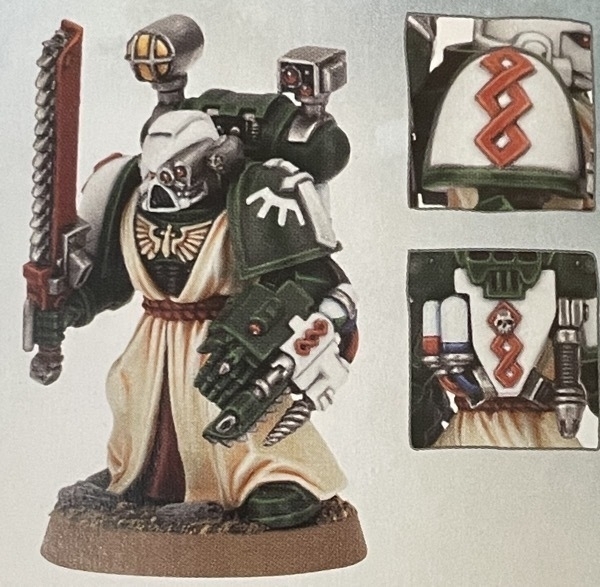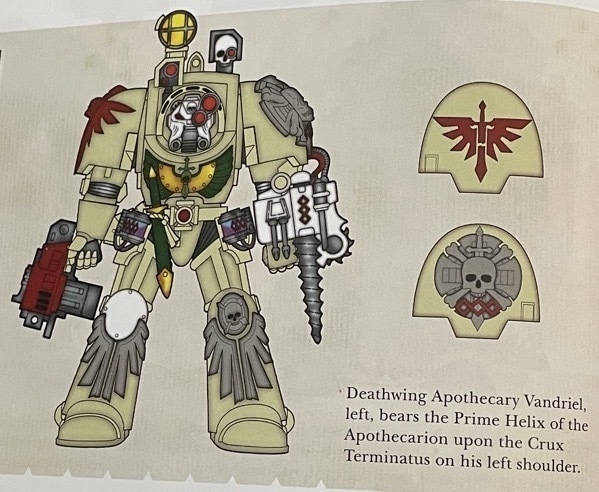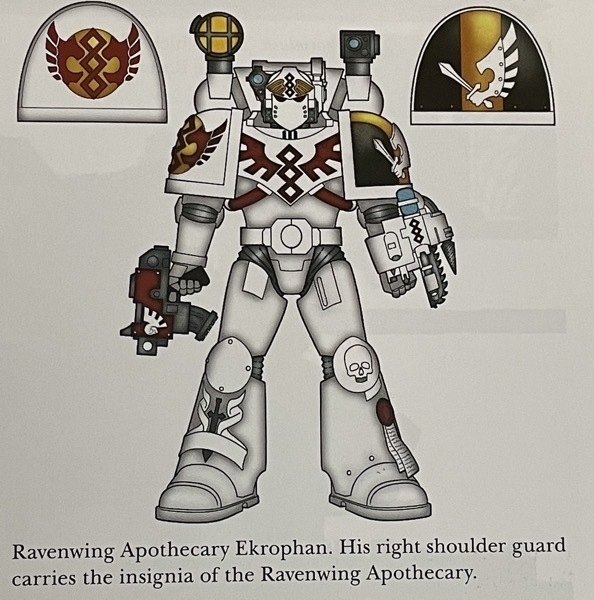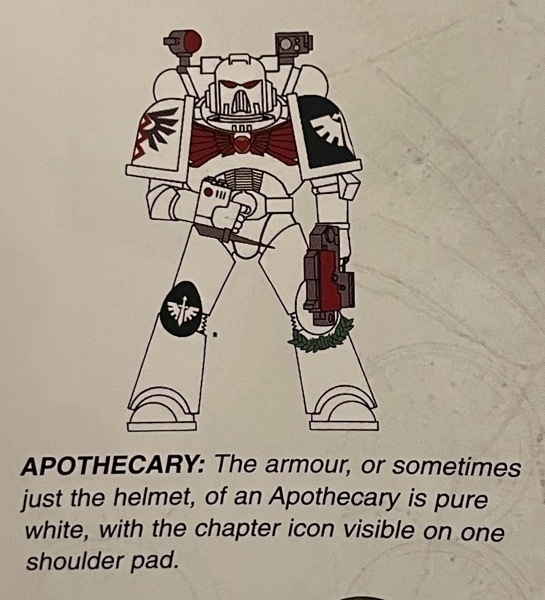-
Teammate 1.0
Teammate: Kill Team Spec Ops Aide is out now. This is an app I’ve been working on throughout the fall. It helps you manage narrative campaigns in Warhammer 40,000: Kill Team.
You can download it now for free from the App Store for iPhone, iPad, and Mac.
Like many, the pandemic found me at home in need of a hobby, and wound up picking up a brush and painting Warhammer miniatures. I’d started playing 40K in high school during 2nd edition and had from time-to-time wandered into game stores, my army sitting in a few boxes in a closet.
when 9th edition came out, I was drawn to the idea of smaller narrative games, and Kill Team’s Spec Ops rules seemed ideal for telling stories about your squad of little friends. Right away, though, I found the work required to track experience, battle honours, strategic assets, etc. to be cumbersome.
Teammate is deisgned to streamline that bookkeeping. You still need to know the rules for how the Spec Ops mode works, but it should be able to replace having to lug a clipboard around.
There’s a little more information on the About Teammate page, including a video demo.
-
Also, Our Flag Means Death aired this year and was good.
-
Creeper updates this rhyme: “You’re cheap and you’re haggard.”
I appreciate the effort but it loses the bite of the original. I think maybe I’d just rewrite the couplet entirely.
-
Glass Onion: A Knives Out Mystery. 👍🏻
-
I’m finally working my way through The Expanse. I think the key was not in getting over the fact that Holden is so different than the book, but in finding other ways to like the series despite the scenes he’s in.
-
I’m only in a couple of Discords and keeping up with them feels like work.
-
I painted up a Blitz Bowl team in W&M Tribe colors. Turns out the actual team is really good this year, even!
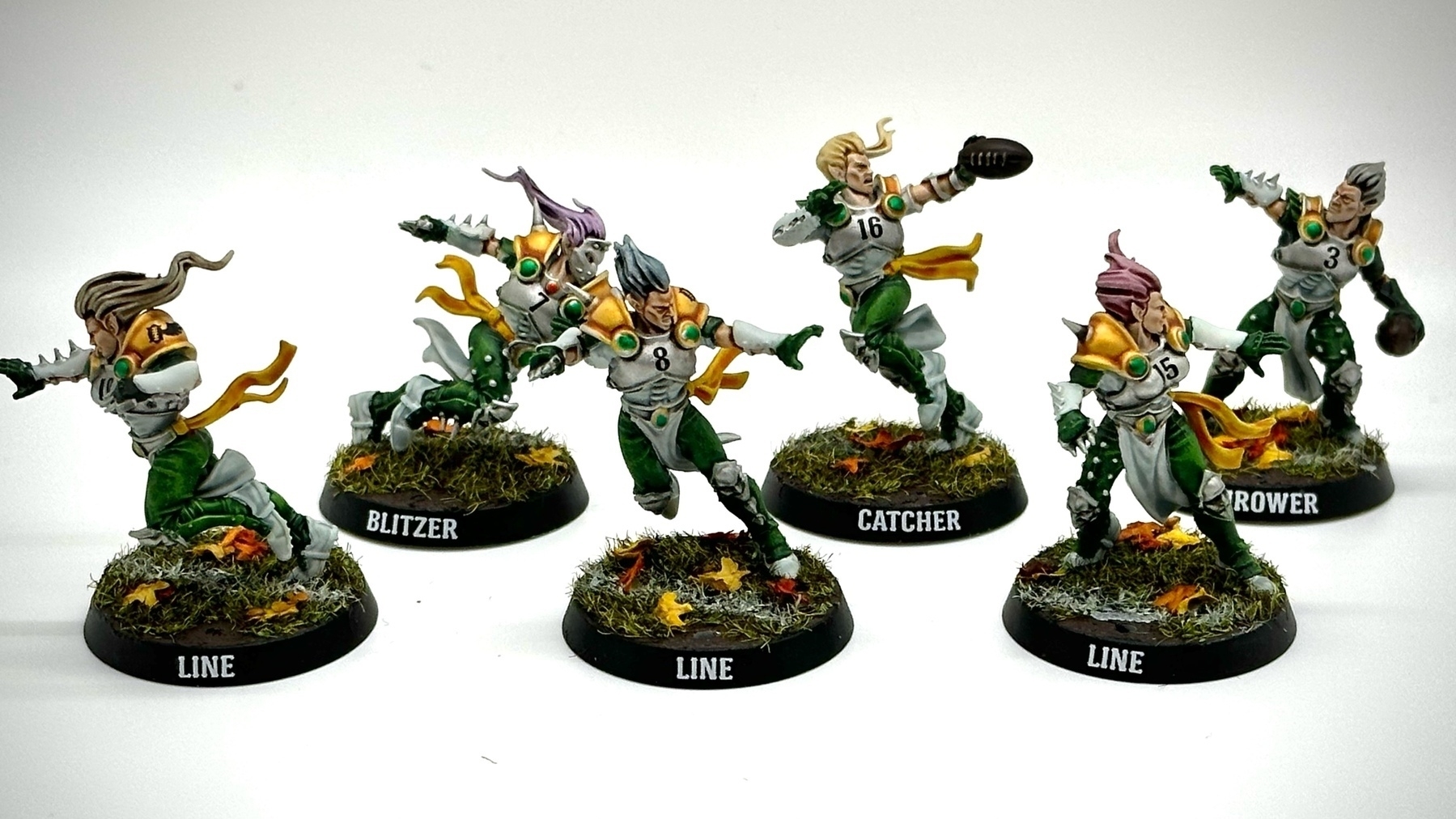
-
Without Twitter how will Megan Amram notify us which day is the day Donald trump finally becomes president?
-
At some point recently Apple removed the awful “playback speed” button from the Apple Watch “Now Playing” screen. Hitting this by accident was basically a destructive action.
-
I have a slight concern people are seeing Andor and thinking what we needed was “adult Star Wars” and not “good Star Wars.”
-
Writing about the (hearsay) reasons for the Dark Angels’ color change last week got me curious about how the chapter’s look and story developed over the early days of Warhammer 40,000. Naturally, this led me to pour through PDF copies of Rogue Trader and every White Dwarf magazine released through the second edition of the game. Below I’ll lay out the timeline for how both the story and the look of the army changed over the years.
In short: The Dark Angels start off wearing black until a Jim Burns painting shows them with a green cast (Sep ’89). The Ravenwing as a mobile company was established early on (Dec ’87). Lion El’Jonson’s rivalry with Leman Russ is mentioned but little else is established. The Deathwing were added with the release of the Space Hulk Deathwing expansion, which orignated their American Indian motif and white armor (Nov ’89). The “Unforgiven” story didn’t come along until quite late, appearing in a short blurb in second edition’s Codex Imperialis in ’93 but not fleshed out until Codex: Angels of Death in ’96.
Here’s a timeline of every time the Dark Angels were mentioned that I found. (I’m sure I missed some but I hope you’ll agree this is thorough enough). I’m using the White Dwarf cover dates, which might be slightly off from their actual street date.
Prehistory: I can’t begin without mentioning Lionel Johnson and his poem, The Dark Angel. I don’t have any information as to whether GW came up with the name Dark Angels and then discovered the poem or if someone knew of the poem first, but the chapter’s Primarch is definitely named for the poet and its story of shame and concealing a dark secret is a likely inspiration for the chapter’s backstory.
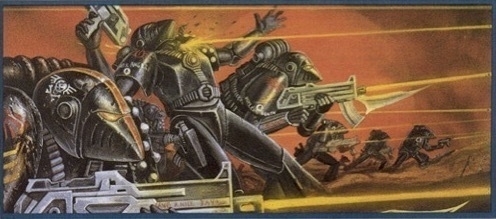
1987’s Rogue Trader has only a little background information about the discrete Space Marine chapters. Page 12 has several examples of Dark Angels wearing all black with a red stripe down their helmet.
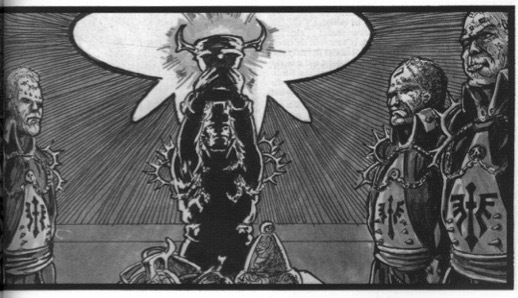
Page 138 describes the Feast of the Malediction:
The celebration of the Feast of Malediction by the Dark Angels Chapter of Space Marines. This great annual event takes place in the Seclusiam of the Dark Angels’ space fortress which orbits the giant planet Delahon. The feast celebrates the founding of the Chapter by Lynn Elgonsen at the beginning of the Imperial Crusades almost ten thousand years ago. The Dark Angels are honoured as the first Marine Chapter. They were founded by the Emperor at a time when he still lived in the conventional sense. Within the Chapter the title of the Dark Angels’ leader is Custodian, an honour which acknowledges the Emperor as the Chapter’s true leader. The Cup of Retribution used in the ritual is said to be the actual vessel from which the Emperor drank at the original founding of the Chapter. At the culmination of the feast, the Custodian takes a small knife and cuts his thumb so that a drop of blood falls into the cup. The cup is then passed around the all the assembled fighting brethren who each add a little of their own blood. Once very warrior has contributed, the contents of the cup are mixed with wine in a number of large open barrels. The cup is then passed from warrior to warrior, each filling it and drinking from the wine in turn. This ancient ritual is sacred to the Dark Angels and it is considered a bad omen is a long campaign or sudden battle delays the feast.
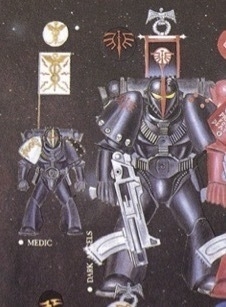
Page 156 describes Space Marine armor colors and badges. “The Dark Angels wear only black.”
White Dwarf 93 (September) announces Rogue Trader and the world of Warhammer 40,000. A two-page spread describes the dark future and the Emperor and includes a Dark Angels logo among several other chapters’. A spread showing the plastic “Imperial Space Marines” says, “There are a thousand different Space Marine Chapters including such renowned names as Spacewolves, Crimson Fists, Dark Angels and Silver Skulls.” A spread in WD 94 shows some black-colored Dark Angels miniatures.
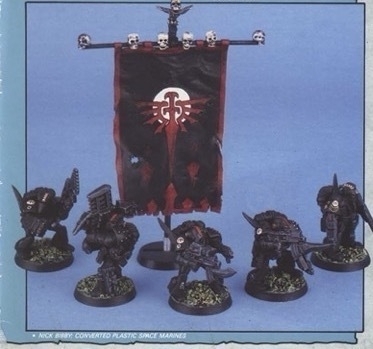
White Dwarf 96 (December) has the first “Chapter Approved” article, on the Mk14 Jet-Cycle “Bullock.” It highlights “The Raven Wing,” which at this point was the seventh company (not second) and deployed exclusively on jet-cycles:
There are ten companies (each of a hundred battle-brothers) making up the fighting brethren of the Dark Angel chapter of Space Marines. […] Number seven company is a specialised recon and attack company, known as the “Raven Wing.” Instead of the usual Dark Angel motif Brothers of the company sport a black wing overlaid by the company number on the right shoulder Armour. Equipped and trained for high-speed reconnaissance, the Raven Wing specialises in hit-and-run warfare and search-and-destroy missions.
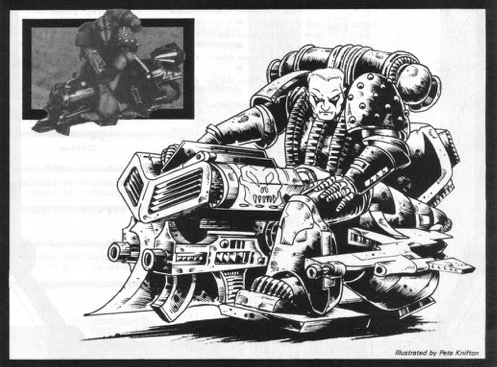
The Primarch is named for the first time, though his name and story at this point are depicted as partially lost to history:
History. The Raven Wing’s exact origins are lost in the history of the First Crusade (circa thirtieth millennia—about ten thousand years ago). Indeed little is known about the Dark Angels during that time. The Chapter’s early history was removed from all Imperial records following the Horus Heresy and the banishment of the nine “treacher-legions” to the Eye of Terror. The reason for the erasure is now known only by the Emperor himself.
According to legend, the Chapter was founded by Lynel Jacobsen or Jonsen, a man whose reputed exploits include the incineration of Goyas Asteroid and the first sub-light circumnavigation of the Outer Dolmans. He is said to have died defending the honor of the chapter in a duel with Leman Russ (founder of the Spacewolves). This may be true, but it is more likely that the story was invented following the inter-legionary wars in the thirty second millennia. In any case, the two chapters have remained rivals at best (and outright enemies at worst) ever since.
It goes on to detail a battle over Rynns World featuring ten Raven Wing squads plus its captain and staff. The force was led by Captain Gaius Oblonsky, Lieutenant Djinn Ntonnik, Medics Kyle Kildare and Cassius Hacit, Astropaths Vedi Lazar and Rumman Koak, and Communications Mayer Rufus and Clof Bibulus. Squads were broken into two combat squads of five, led by a sergeant or the next-most senior Battle Brother. Names given are Lex, Gorz, Logos, Palchis, Albius, Habz, Tegulus, Malsh, Salireh, Kuhn, Credens, Erek, Capsus, Kanz, Eboracus, Lowg, Vincius, Dukh, Casula, and Vengt.
1988
White Dwarf 102 (June) has an “Index Astartes” feature on medics. It shows a Dark Angels medic in black but with a white torso and power pack.
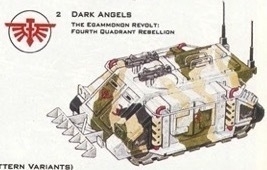
White Dwarf 103 (July) has a Dark Angels Rhino in a “Sub-Attic Tundra” camouflage pattern.
White Dwarf 105 (September) has an “Index Astartes” article which notes, as an example of “Variation from the Codex”: “A good example of organisational variation is provided by the “Raven Wing of the Dark Angels Chapter. This entire company is equipped with M14 Bullock jet cycles as appropriate to their high speed reconnaissance role.”
White Dwarf 108 (December) describes Space Marine Chaplains. It has a guide to “Typical Chaplain uniform variations,” which lists Dark Angels Chaplains as wearing skull helmets, black torsos and legs, and skull shoulder pads.
1989
White Dwarf 112 (April) shows a Dark Angels Terminator still in black armor.
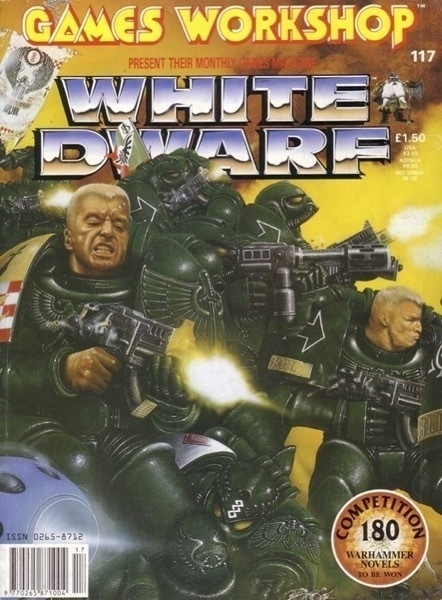
The cover for White Dwarf 117 (September) is a Jim Burns painting that was also used as the front of the Space Marine (Epic) boxed set along with metal band D-Rok’s Oblivion. The marines on the cover are definitely green, though I’ve seen other reproductions of the artwork where they’re much darker—black with a green tint rather than green. Regardless, more or less from here on, Dark Angels wear green.
The ’89 Space Marine rulebook, page 61 has a section on “Uniform Colour and Banner Chart.” It says the Dark Angels’ base coat should be black with a highlight of Salamander Green.
WD 117 has a feature on Leman Russ that mentions the Dark Angels, expanding on the story from WD 96. The Dark Angels’ Primarch now has his current name:
On the world of Dulan, the Space Wolves and Dark Angels were to assault an enemy held fortress. Russ claimed the right to lead the attack, but “Lion” El’Jonson, commander of the Dark Angels, refused and started the attack early. Russ was furious, and began a feud which was to continue for three centuries. The Emperor intervened to quell the fighting, and ordered that the disagreement be settled with a duel. Leman Russ faced his friend in combat and took a blade through the heart; the duel was declared a draw, and the normally fatal wound healed within weeks.
The Primarchs were to fight four more times before the death of El’Jonson. Friends to the end, they were united by shared rivalry and sense of honour. The feud would arise again, but not in Russ’s lifetime.
White Dwarf 118 (October) has an ad for Space Marine transfer sheets for Space Wolves, Ultramarines, Blood Angels, and Dark Angels. These are now the four main chapters Games Workshop will feature going forward.
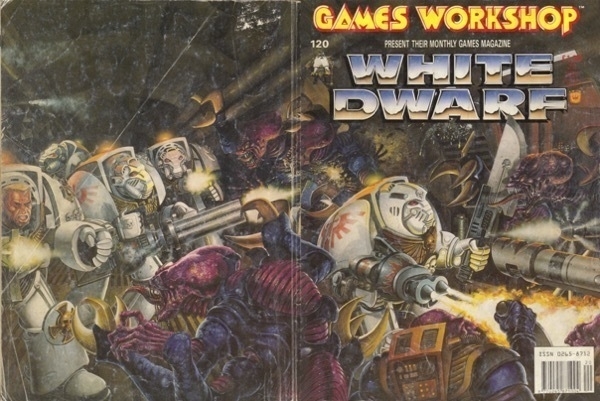
White Dwarf 119 (November) announces the “Death Wing” expansion of the Space Hulk game. №120 (December) has a Deathwing front and back cover. The Deathwing now wear pure white armor, not the more yellowed bone/cream color in current use.
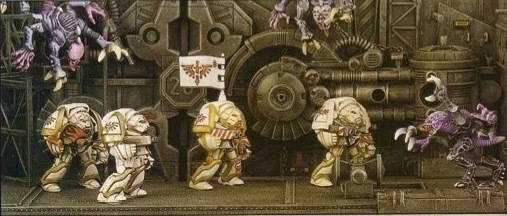
The Deathwing game also saw release of a short story by Bryan Answell and William King. It included art by Kev Walker (and maybe others) that gets featured in many WD issues over the next few months. Established in this story:
- The Dark Angels recruited from a planet called Plains World. Their culture, as explained later in WD 195, had a population that “shared many of the traits of the Native American Indians of our own planet.”
- The names of the Deathwing troopers include Two Heads Talking, Weasel-Fierce, Lame Bear, Cloud Runner, Bloody Moon, and Eagle Wing. It notes that when they joined the Dark Angels, they took on other names such as Ezekiel.
- In the story, the Terminators repaint their armor white, which represented the color of death (bones). After the mission, all Deathwing are colored white in honor of their victory over the Genestealers in the story.
1990
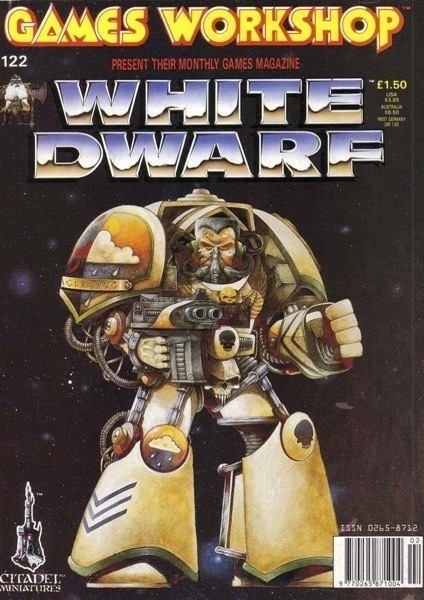
White Dwarf 122 (February) has Eagle Wing on the cover, an ad for Space Hulk and the Deathwing expansion featuring some Dark Angels Terminators (still in pure white), and some Deathwing Terminator artwork.

White Dwarf 123 (March) has the first Dark Angels miniature wearing green in an ’Eavy Metal section.
White Dwarf 126 (June), in an article on Epic Space Marines, which is set during the Horus Heresy, describes the “Regimental Organization of the Founding Chapters”:
The Dark Angels have a powerful attachment to the rituals and traditions of their homeworld. In honour of their ancestors, they apply the ancient precepts of battle to their forces: find your enemy’s weakness, test your skills against him and then make the killing blow. To this end, a Dark Angel regiment often has the three companies of the 1st Battalion dedicated to this ideal: Death Wing, Iron Wing, and Raven Wing. Sometimes the entire regiment is organized on these lines but this is rarer.
The Death Wing, Iron Wing, and Raven Wing are called the 1st, 2nd, and 3rd companies, respectively.
An ad for the Space Hulk Genestealer expansion shows an illustration of a Deathwing Chief Librarian in white but with yellow (or gold) trim. An ’Eavy Metal miniature has a Deathwing Terminator painted in this scheme: white with some yellow shading and yellow trim.
White Dwarf 127 (July) has an ’Eavy Metal spotlight on Rob Baker showing off some Deathwing conversions with lots of American Indian influence. For the first time we see a Deathwing Terminator with feathers, which would become a key piece of their iconography. The next issue has a Terminator Librarian in the ’Eavy Metal section.
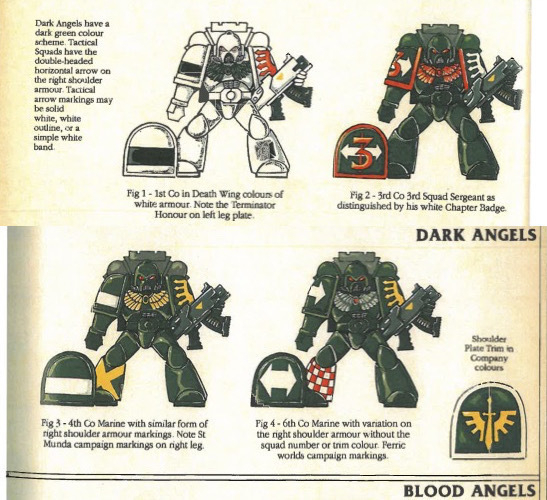
White Dwarf 129 gives us an article on Space Marine armor types and a feature on Tactical Squads. It shows Dark Angels wearing green but adhering to the Codex convention of using company colors for shoulder trim (and also chest eagles). We also see a Deathwing marine in Power Armor.
The Dark Angels are instantly recognisable by their traditional very dark green colour scheme. The chest eagle motif varies in colour depending on the company as described below. The left shoulder armour plate bears the Chapter badge in yellow with a trim in the company colours (ie same as the chest eagle). Tactical Squads are distinguished by a plain horizontal double-headed white arrow on the right shoulder. An alternative version is a simple white band alongside the rear edge of the armour: this is an especially common adaptation during long campaigns but it has become an acceptable alternative to the standard arrow either for whole squads or individual Marines. Another alternative is a double-headed arrow in outline only.
The codex dictates that the arrow bears the squad number in the company colour and that both shoulder pieces should be outlined in the same colour. However the Dark Angels do not stick as rigidly to the codex as the Ultra Marines, and many squads do not display the squad number or it may be worn only by the Sergeant. Sometimes the number is not in the company colour but is black or white instead—this is a common compromise during a campaign. Similarly the edging trim colour is often missed off the shoulder and the chests eagle may be the same colour as the armour. Sergeants are distinguished by the white Chapter insignia instead of their brother Marine’s normal yellow. Individuals companies are identified by the colour of their chest eagles, shoulder trim and Squad numbers as follows:
Chest Eagle colors. 1st Co. - dark green, but the 1st company is an exception to the normal rules as described below, 2nd - white, 3rd - red, 4th - yellow, 5 - black, 6th - grey, 7th - light green, 8th - blue, 9th - purple. As with the Ultra Marines the 10th company is considered as a reserve or training company and as such as no Tactical Squads and so is not illustrated here.
The exception to this overall scheme is the 1st Company. The 1st Company is made up of Marines who would otherwise wear Terminator armour and comprise the famous Death Wing. Just as the Death Wing traditionally wears all white armour, so the 1st Company has all white power armour. The Tactical Squad markings and other details that would normally be white are black. The chest eagle is the same green as the normal armour colour while the Chapter badge itself is red rather than yellow.
White Dwarf 130’s ’Eavy Metal pages show Deathwing in Power Armor and a Dark Angel Scout (October).
In №132 we have (December) Deathwing Terminators painted by Stuart Willis that look more like the current style—white with a wash of brown and yellow.
1991
A new version of Space Marine came out. Page 30 of the rulebook has brief background on the Space Wolves, The Dark Angels, The Ultramarines, and The Blood Angels:
The Dark Angels are age-old rivals of the Space Wolves. When they fight together each Chapter will try to outdo the other, recalling the ancient rivalry between the two original founders of these Chapters: Leman Russ Primarch of the Space Wolves, and Lion El’jonson Primarch of the Dark Angels. On eleven occasions in their history the two Chapters have gone to war against each other, the most recent being the Magdelon War in which the Space Wolves finally ousted the Dark Angels from the second moon of Magdelon and its famed gem mines. The Dark Angels uniform is very dark green and their badge is the winged dagger.
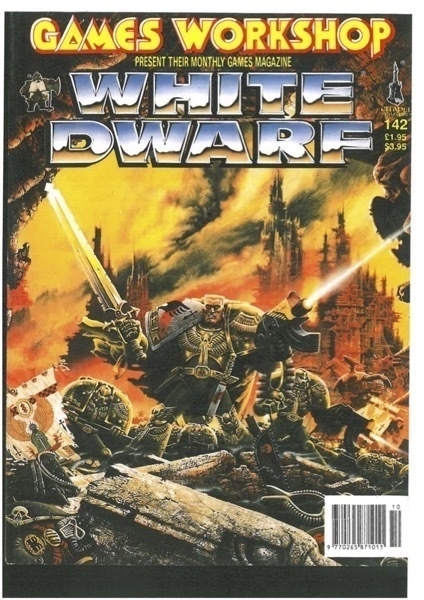
White Dwarf 142 (October) has Dark Angels on the cover, painted by Geoff Taylor. In a painting guide article for the Space Marine game we get the first mention (I think) of the Ravenwing being black. At this point the guidance still has the Dark Angels using different colors for each company like a regular Codex chapter:
- Deathwing: Skull White
- Ravenwing: Chaos Black
- Battle: Goblin Green
- Battle: Hobgoblin Orange
- Battle: Blodo Red
- Tactical: Enchanted Blue
- Tactical: Worm Purple or Grey
- Assault: Moody Blue
- Devastator: Sunburst Yellow
- Scouts: Salamander Green
The Dark Angels are slightly different to the other two Chapters described above [Ultramarines, Blood Angels] in that they have a slightly different mix of company types: one less Battle Company and a new type of company called the Ravenwing. This is a mobile mounted company riding fast vehicles, bikes and speeders. The basic uniform colour of the Dark Angels is Salamander Green, a rich dark green colour, but there are two exceptions. The Deathwing is the name of the Dark Angels’ Veteran Company and wears all white armour; the Ravenwing wears all black armour.
The company colour is optionally used for the right shoulder pad, but the company banners are all black except for the Deathwing’s, which is white. Each company HQ unit’s banner has the Dark Angel’s symbol, a winged dagger, in its own company colours except that the Deathwing has a black symbol, the Ravenwing a white symbol, and the Scouts have an unwinged dagger in either white, yellow, or red. These badges are not always used—they are optional and you may prefer to miss them off as indeed the Dark Angels themselves will sometimes do in combat. Shoulder pads can also be painted with company colours if desired.
Here and elsewhere it’s mentioned often in this era that Space Marines are not consistent about their uniforms. Marines in a particular campaign might use coloring and markings that are different than others’. (This is, of course, good story cover to explain why different players’ armies look different.)
1992
White Dwarf 146 (February) has Dark Angels Scouts on the cover and a diorama of Dark Angels called The Last Stand. It depicts a Deathwing marine in Power Armor.
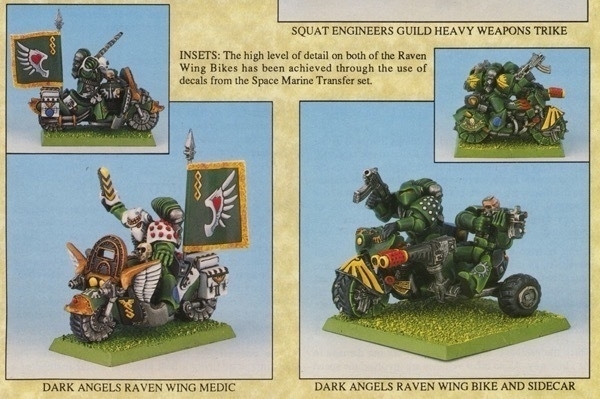
White Dwarf 149 (May) shows off Ravenwing bike models painted green. The medic flies a banner with a wing that looks very close to the current Ravenwing insignia, minus the sword/dagger in its hand.
Raven Wing Bikes: The Raven Wing is the second company of the Dark Angels Space Marine Chapter. It is completely mobile, which makes it a quick and deadly attacking force.
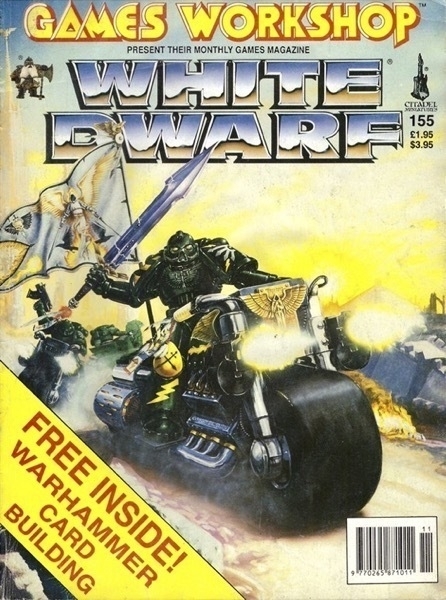
The next several issues have a few models. White Dwarf 150 (June) prints some wonderful John Blanche Dark Angels art. 152 shows a Dark Angels Captain, 155 has a cover by Dave Gallagher showing bikers in green. (From here on I’m going to skip issues that just show a Dark Angels model unless they’re notable in changing the look in some way.)
1993
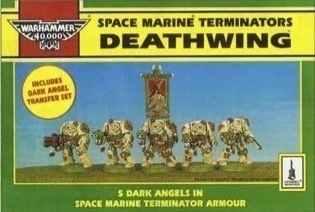
White Dwarf 161 (May) introduces the new metal Deathwing models. An article by Andy Chambers shows off new rules for using them in game and reiterates the story about why the color their armor white. It also says that the “Deathwing is particular blessed in that it has one hundred suits of Tactical Dreadnought armour, enough to equip the entire company.” The story hasn’t yet solidified around the idea that the Dark Angels’ first company only wears Terminator Armour, but it’s getting there. It also starts to build up the idea that the Dark Angels have a wealth of equipment that other chapters don’t—not every chapter can put its entire first company in Terminator Armour—they just don’t have that many suits.
Later in that issue is an article on the Horus Heresy. The Dark Angels only get a brief mention. Note the “h” in the Lion’s name:
A loyalist fleet under Leman Russ and Lion’el Johnson bearing a fresh army of Space Wolves and Dark Angels was only hours away. It would take days to break humanity’s last citadel, even with Horus leading his troops. It seemed that time had run out for the Warmaster, that his gamble had failed.
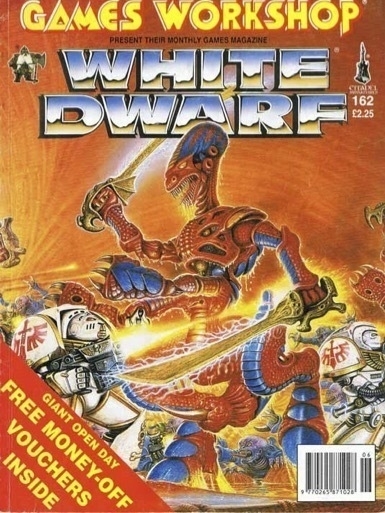
White Dwarf 162
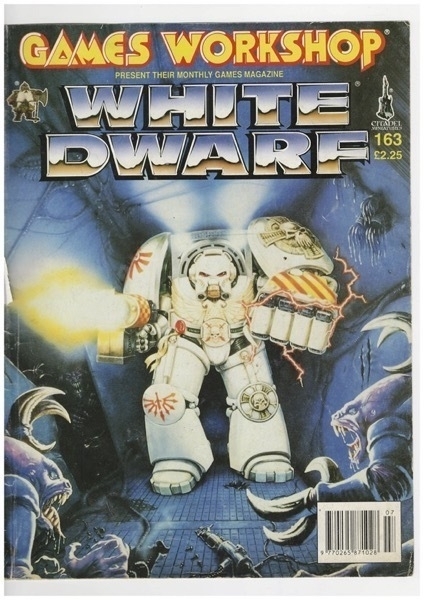
White Dwarf 163
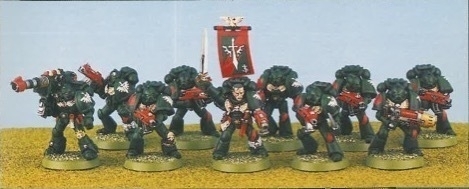
White Dwarf 166 (October) shows off the new Dark Angels Tactical Squad box, complete with a special sergeant model. Second edition is being released and the Dark Angels color scheme is now fairly fixed. Red Boltguns, no special shoulder trim, bone chest eagles.
It includes a section taken from the second edition’s Codex Imperialis book, which finally starts to establish the story of the Dark Angels:
Of the Battle Brothers of the Dark Angels history cannot speak, for there are no records of the Dark Chapter’s beginnings, of their part in the Great Crusade, or of their deeds during the terrible wars of the Horus Heresy. Only the legend persists—the legend that once the Dark Angels teetered upon the brink of Chaos, that foul betrayal besmirched the Chapter’s valour and made vain all acts of former virtue. Yet they returned to the fold of the Emperor’s love and tore themselves from the very bosom of temptation. Perhaps they sought the Emperor’s pardon too late, for ever since they have borne the Mark of the Unforgiven. Can ten thousand years of purgatory absolve those to whom every battle is redemption? Can it be the lost souls of the slain that clamour for the absolution that victory brings?
The next few dozen issues feature Dark Angels models here and there but no major story changes. The Dark Angels get a Dreadnought with Missile Launcher and Assault Cannon and a Predator kit (which is just a regular Autocannon loadout).
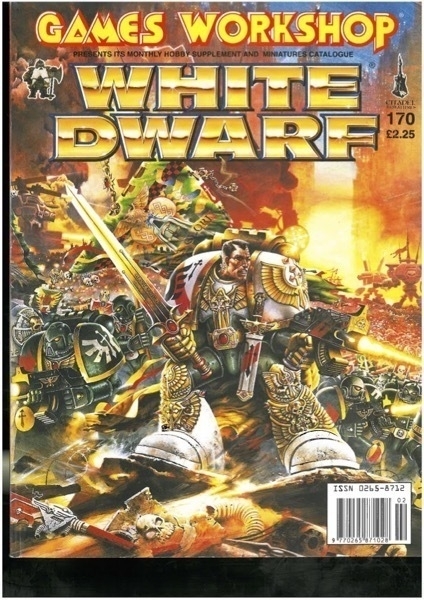
White Dwarf 170
1996
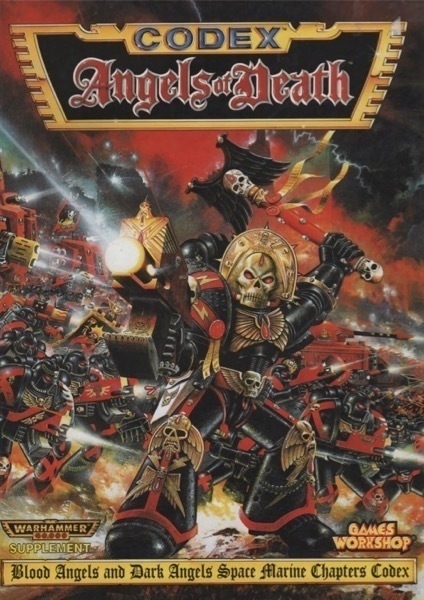
January ’96 sees the release of Codex: Angels of Death, announced in White Dwarf 193, one hundred issues after Rogue Trader’s preview in №93, along with new robed Dark Angels characters. A feature by Jervis Johnson, “Dark Saviors,” talks about new characters Azrael, Ezekiel, and Asmodai. The following issue shows standard bearer Brother Bethor.
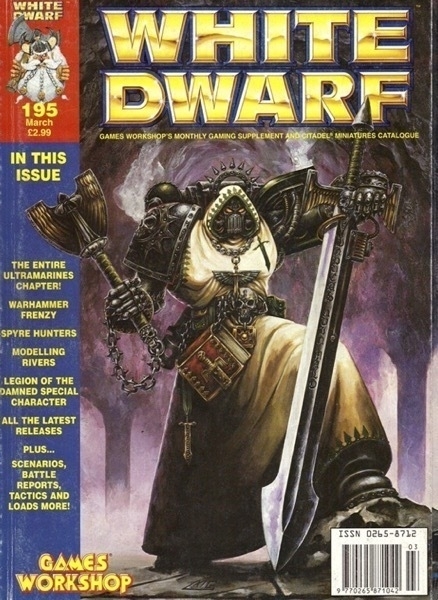
Codex: Angels of Death establishes the story of the Dark Angels, including the hunt for the Fallen, the aesthetic of characters wearing robes, and so on. The next several issues of White Dwarf show off the new miniature line of characters, including a new Ravenwing Land Speeder and a new set of bikes, now all painted black.
What did I learn from all of this (aside from that if you know where to look, you can find PDFs of old White Dwarf issues and rulebooks)? I had thought that the general storyline of the chapter—the hunt for the Fallen—had been in place longer, or had developed over time. In actuality, it was written more or less entirely by Rick Priestley and Jervis Johnson for the second edition codex. Clearly some tidbits germinated before that, starting with the short bit in Codex Imperialis, but I wasn’t able to find anything else about it, aside from a mention of their early records being stricken, prior to then. I do find it fascinating how in addition to crafting this new Unforgiven story, they brought in elements from the previous ten years. The use of a mounted company in the Ravenwing, the idea of a mobile HQ rather than a home planet, the feud between the Lion and the Wolf, and Deathwing Terminators were all brought together and made into one cohesive story. There’s even a little retcon, mentioned in passing about the Angels of Absolution’s armor color, explaining the chapter’s color change to green from black. Extra special credit goes to the way that the story of the Deathwing on Plains World finding their planet had been corrupted by Genestealers is turned into story that’s told to young Dark Angels recruits as a metaphor for the need for constant vigilance against corrupting influence with an eye toward preparing them to hear the story of the Fallen. Great stuff.
Also reading those earlier White Dwarf issues just reaffirmed to me how much personality the original “beakie” models had. I get that the new Primaris models have a better scale to them and look more fearsome, but the old figures were just so expressive!
More in this series:
- Shoulder Pads of the Dark Angels
- Dark Angels Apothecaries
- Why the Dark Angels Really Changed from Black to Green?
- How the Dark Angels story developed, from Rogue Trader to 2nd edition
- Successor Chapters
- My 4th company, “The Feared”
- The Deathwing: History and Complement
- Dark Angels Decals: A Look at Waterslide Transfer Sheets
-
Why the Dark Angels Really Changed from Black to Green?
Continuing my series on the Dark Angels from Warhammer 40,000 (one, two), I wanted to write about the interesting ways that Games Workshop has changed the story to fit the artwork over the years.
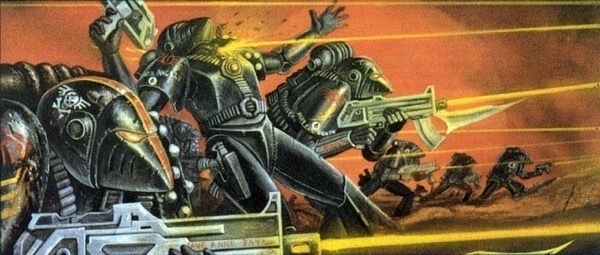
In early, Rogue Trader-era art, the Dark Angels wore black with red accents.
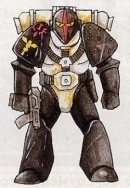
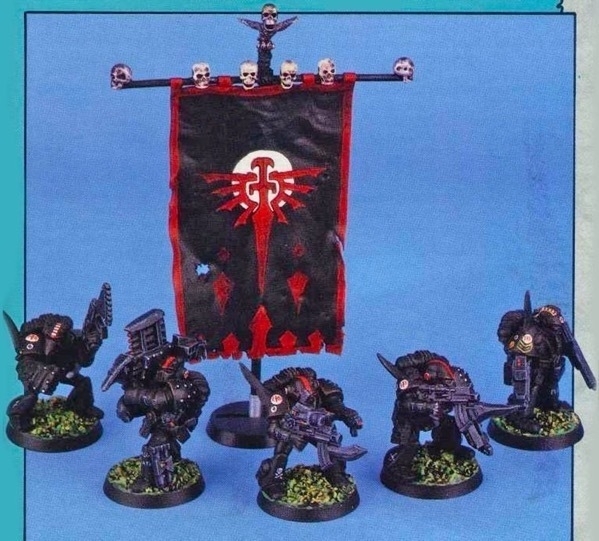
According to this great thread on the topic, the cover of White Dwarf 117 featured a painting of Dark Angels Space Marines that seems to show them wearing green. Bolter and Chainsword member Brother dean:
It is a correct depiction of how shiny black armor will reflect a yellow sky. The story that I’ve always heard is that a ’Eavy Metal painters saw the painting and made them black green.
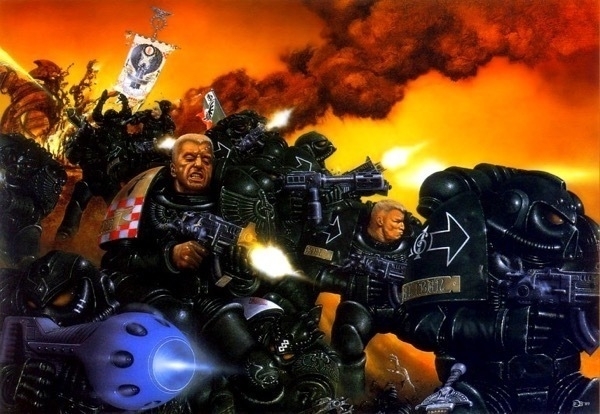
Here’s the cover itself:
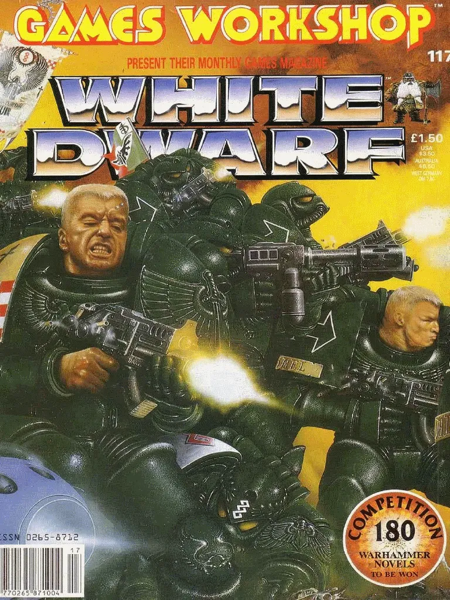
So the army had been painted black until this art came out which showed them with a green cast. The studio painters saw it and from then on started painting the Dark Angels in green. Was this an actual mistake—the ’Eavy Metal team thinking the shiny black armor was supposed to be black—or just a change because they liked the green scheme? Either way, within the year the Dark Angels got new outfits.
At the same time the Deathwing expansion of Space Hulk came out featuring Dark Angels Terminators wearing bone white armor. This resulted in two eventual changes to the lore. First, the idea was introduced that black color scheme was what the original legion wore. There’s one mention of it that I can find in the 2nd edition codex, which refers to the Angels of Absolution having “retained the traditional black armour of the original Dark Angels Legion.” Later stories would say that after the Heresy and the destruction of Caliban, the chapter repainted their armor in honor of the green forests of their homeworld.
Meanwhile, a similar story was written to explain why the Terminators now wear bone white armor instead of black, which was that a squad of Deathwing Terminators returned to their homeworld to look for new recruits but found it “in the grip of a Genestealer infestation.” They repainted their armor to the color of bone, which represented death in their culture, and the Deathwing ever since has used that color in honor of their victory. (That story also featured American Indian imagery—the world was called Plains World, the characters had names like Cloud Runner and Two Heads Talking, and Dark Angels and Deathwing models started featuring feathers as decorations. Over time GW would walk back this icongraphy and wrote a story explaining that the Dark Angels recruited from many worlds, including Plains World, and that the Battle Brothers take new names upon joining the chapter, so Cloud Runner and Two Heads Talking became “Ezekiel” and “Lucian.” This allowed them to play up the Dark Angels as grumpy knights while still retaining the Indian-inspired story elements.)
Similar changes have been made elsewhere. Over time GW changed the how Space Marines’ boltguns look slightly. It now sells a line of Horus Heresy-era miniatures wearing archaic armor which are designed to look like the older armor and gun designs, making the retro looks old in the senses both of the miniature range and the storyline. On a much larger scale, the game’s rules got a major overhaul in 8th edition, but the Horus Heresy game, set 10,000 years before the setting of the regular game, retains many parts of the previous rules system. In essence, and entire ruleset was retconned. It’s similar to how DC Comics would alter its storyline or move entire characters to an alternate Earth to explain differences between old issues and newer plots. GW could have just made these changes without explanation, but it’s much more fun to write them into the story.
(One last example I really like: A recent storyline involved the creation of a whole bunch of new “Primaris” Space Marines. A large number of these were not assigned to any particular chapter but instead served as reserve forces for a large campaign. On their shoulder they wore a grey chevron symbol, from which they got the nick name “Greyshields.” This grey is intended to be the same color as unpainted plastic models. They’re Space Marines who are fresh out of the box.)
Hobby-wise, It might be interesting to try painting a Heresy-era or Fallen force with shiny black armor. I have a Cypher model waiting for paint. I may try a base coat of Leadbelcher and then using a thinned-down Black Templar over it, maybe with some ’Ardcoat to finish it.
Previously:
- Shoulder Pads of the Dark Angels
- Dark Angels Apothecaries
- Why the Dark Angels Really Changed from Black to Green?
- How the Dark Angels story developed, from Rogue Trader to 2nd edition
- Successor Chapters
- My 4th company, “The Feared”
- The Deathwing: History and Complement
- Dark Angels Decals: A Look at Waterslide Transfer Sheets
-
Wonder Woman Doesn't Say Hello
In the third issue of Final Crisis (2008) by Grant Morrison and JG Jones, Wonder Woman, fighting Mary Marvel, exclaims “Hola!”
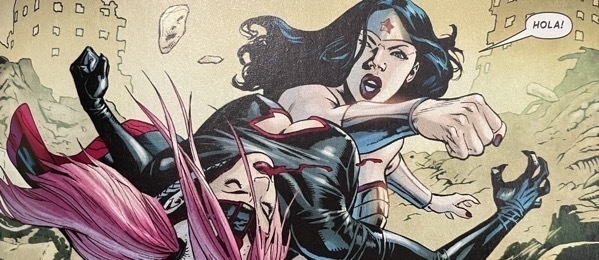
Morrison uses it again in last week’s Wonder Woman Earth One vol. 3:
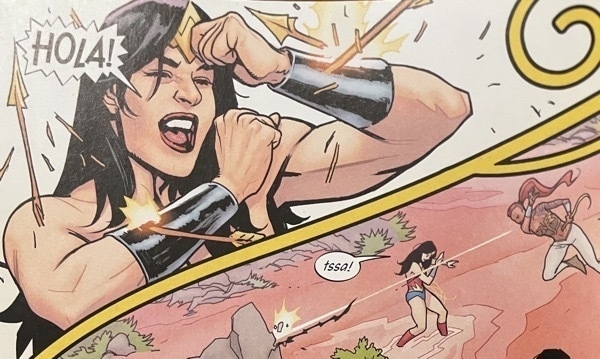
To my American eyes, it looks very much like Wonder Woman really likes to say “hello” to people she’s fighting. In actuality, she’s using a battlecry first seen (I think) in Wonder Woman 1. (She appeared prior to that in All Star Comics 8 and Sensation Comics. WW shows an expanded version of her ASC origin.)
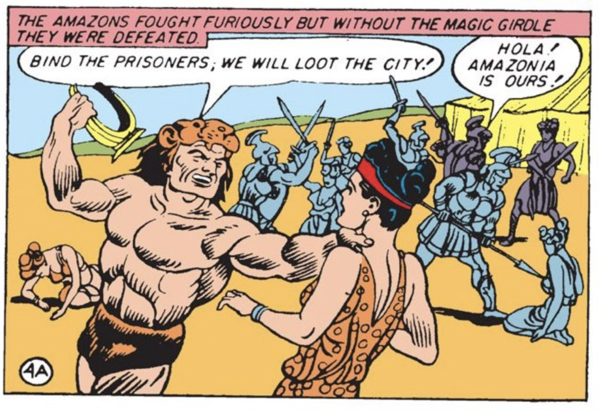
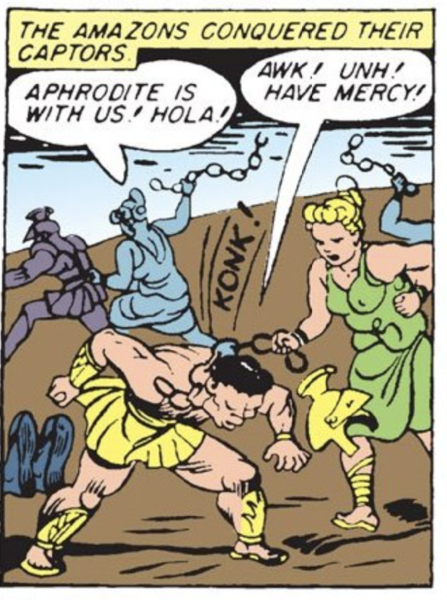
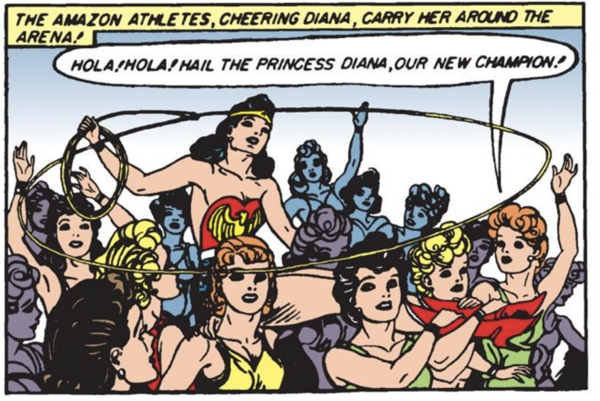
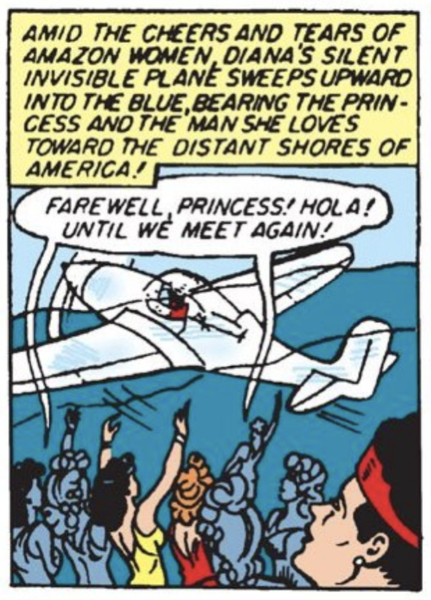
Okay, so if Wonder Woman used this battlecry in her early appearances, then where did author William Moulton Marston get it from? Turns out this is incredibly hard to find on search engines. “Amazon” is an internet company, “hola” is a common Spanish word, and Wonder Woman has a recent movie out, all of which gunk up the results. The best I’ve been able to find—my guess for the moment—is the Ancient Greek battlecry “alala,” which relates to a goddess, niece of Ares, who personified war. Maybe it got transliterated to “hola” at some point and Marston picked it up from there?
I’d love to hear other theories as to why the Amazons in DC Comics use this particular exclamation.
-
Dark Angels Apothecaries
As a follow-up to my previous piece about the Dark Angels, I wanted to take a look at how Apothecaries should be painted. The question: should they be all white, or wear their normal color with white embellishments? (TL:DR: White, in my opinion, but sources differ.)
The basic guidance, as I understood things, was that each Space Marine chapter has its own colors—blue for Ultramaines, red for Blood Angels, and so on—but that Techmarines, Chaplains, Librarians, and Apothecaries wore their own colors of office—red, black, blue, and white, respectively—instead, with just the left shoulder pad showing their chapter’s colors. For medics, especially, it makes sense to have them be easily identifiable. In present day (though this would certainly be laughable in the grim, dark future of the 41st millennium) medical staff are not supposed to be treated as targets.
Here, though, is a Rogue Trader-era photo which shows a good bit of variation.
Note the Dark Angels example, bottom-right, in what’s now considered to be their pre-heresy color scheme along with a Consecrators-like stripe on his helmet.
By the second edition of Warhammer 40,000 they were wearing all white.
Second edition codex
His left shoulder pad is green and shows the Dark Angels symbol but could otherwise be an Apothecary for any chapter. (He’s also wearing his 3rd company designation on the wrong knee. How embarassing!)
The sixth edition codex makes a change. We have a robed Apothecary wearing green with a white helmet, right shoulder, and narthecium.
Sixth edition codex
Seventh edition codex
Deathwing Apothecaries are shown in bone with white accents.
Sixth edition codex
In eighth edition, however, we get an illustration of a Primaris Apothecary in white.
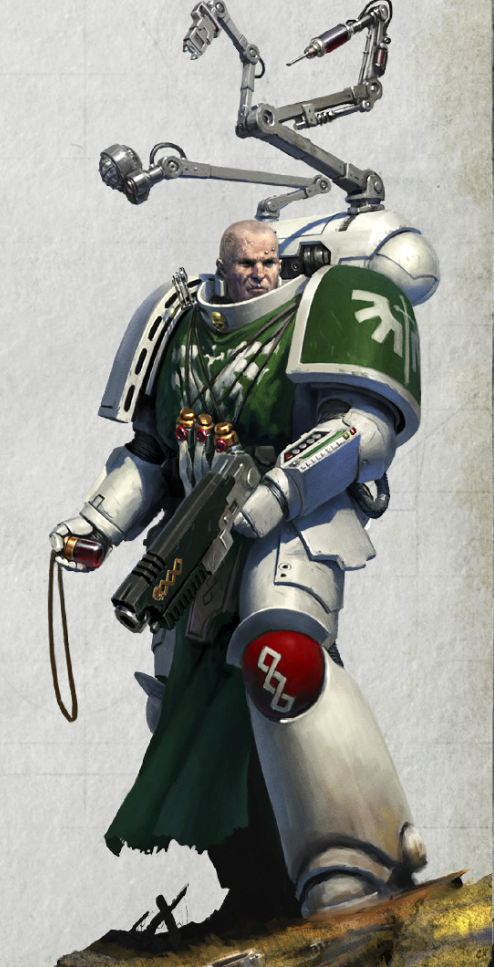
Eighth edition codex
Black sidearm, though, rather than red. This is another detail that’s changed over time. 3rd edition-era Dark Angels carried black guns, but that didn’t last. They’ve been shown red more often than not. Also note that his kneepad has a helix, not a company badge. Each company does have its own Apothecary, so either this is an error or this is how they show they’re not attached to a particular company.
Ravenwing Apothecaries have always been depicted in all white.
So which is it: white or green (or bone or black)?
The real answer, as always, is that they’re your models and you can paint them however you want. Here we have a case where the official books even give you both options. I’ll argue for white, though. The Blood Angels’ Sanguinary Priests tend to wear a lot of red, but they have an in-story reason for differing from the codex: they partially serve as company spiritual figures since the Blood Angels’ Chaplains are devoted to babysitting their battle brothers who have fallen to the black rage. Iron Hands don’t paint their Techmarines red which implies they’re not kept at as much of a distance. Dark Angels don’t give any special role to their Apothecaries—they’re not even Inner Circle.
So why is the Deathwing apothecary in bone? (He actually is Inner Circle since he works with the Deathwing day-to-day and it would be rude for them to have to shut up whenever he entered the room.) I suppose there’s an argument that his Deathwing-ness overrides his medic-ness, but I think it’s just what the studio painter happened to decide. Maybe they thought it looked strange to have one model wearing a different color than the rest of his squad. Him wearing his company colors would match the green Apothecary of the era (though not the white Ravenwing one).
I’d like to construct an argument that the 8th edition Primaris Apothecary in all-white represents a decision by Games Workshop to roll back the variant for the Dark Angels, but really that’s wishful thinking on my part. It’s probably actually the case that the artist just painted him white, and I’ve not seen an official studio model of a Primaris Apothecary in Dark Angels green. Early promo art for the Dark Angels Combat patrol showed they didn’t even have a Primaris Chaplain model—his shoulder pad is clearly from an Ultramarines collection—and it differs from the color scheme seen in the codex which has him in a green robe. All of which to say, not all of Games Workshop treats this stuff as rigorously as I’d like.
I’ll leave the last word to the fourth edition of Codex: Dark Angels:
“The armour, or sometimes just the helmet, of an Apothecary is pure white, with the chapter icon visible on one shoulder pad.”
More in this series:
Previously:
- Shoulder Pads of the Dark Angels
- Dark Angels Apothecaries
- Why the Dark Angels Really Changed from Black to Green?
- How the Dark Angels story developed, from Rogue Trader to 2nd edition
- Successor Chapters
- My 4th company, “The Feared”
- The Deathwing: History and Complement
- Dark Angels Decals: A Look at Waterslide Transfer Sheets
-
Shoulder Pads of the Dark Angels
Of all the things I have opinions and knowledge about, surely some of the least important must be the proper way to mark squads of Dark Angels Space Marines from the tabletop wargame/hobby Warhammer 40,000. When I started playing the game in 1996 or so, this stuff wasn’t so complicated. The 2nd edition codex had two full pages on how to mark your squads! But now, with dozens of different unit types in the game, I see a bit of confusion about this online, so I hope this guide will be useful to anyone who’s curious about this stuff.
A few notes before I begin. First, feel free to ignore all of this and paint your army however you want! They’re your models, after all. Second, it’s common for a Space Marine chapter while on a long crusade to change up its markings as needed, combine companies together as they take casualties, adapt their squad types for missions, etc. Third, while the books say the Dark Angels generally follow the Codex Astartes aside from the first and second companies, they also they like to be a bit mysterious and do stuff to suit their own purposes. In particular, it’s rumored that Azrael keeps the roster at well over 1000, which would have implications on a lot of the squad numbering I mention below. All of which to say, there are lots of reasons to deviate from any of this stuff.
Also, when I talk about left/right shoulder/kneepad, I’m always referring to the model’s left or right.
Choosing Your Company
All of your “greenwing” units belong to a company, typically the 3rd–5th, though if you wanted you could make a force out of a Reserve Company (6th–9th). It doesn’t matter which company you choose. The left kneepad of every member of that company will display its symbol, which can be seen here. The 3rd is the easiest to paint. If you intend to run Lazarus and not a generic Company Master, you should consider painting them as the 5th, or you can make up a story for why Lazarus is leading a different company, or why someone else is leading his—maybe he’s on vacation. (Dark Angels vacations are solemn affairs with lots of incense.)
Most marines will have their company marking on their left kneepad. There are some exceptions:
- Deathwing and Ravenwing units don’t put anything special on their knees. Their armor color tells you what company they’re in.
- The Scout company doesn’t have a knee marking. Note that in addition to scouts, the 10th company has a full complement of Vanguard squads (Infiltrators, Incursors, Reivers, Eliminators, Suppressors, Invictor Warsuits), so an Infiltrator squad, for example, might be from any of companies 3–7, or 10. (But not 8 or 9 because they’re all close support and fire support squads, respectively).
- Each company has 1 chaplain and 1 apothecary in addition to its other command squad units, but there are chaplains and apothecaries that are not part of a company, so you can decide if yours is attached to that company or unassigned and paint his kneepad accordingly. Interrogator-Chaplains, Techmarines, and Librarians are not typically of a particular company. Even if they’re wearing Terminator Armour, they’re still not part of the 1st Company and so should also have green shoulder pads. (Asmodai or Ezekiel signs their checks and approves their overtime, not Belial. Codex: Dark Angels (2015) shows an Interrogator-Chaplain in Terminator Armour with a green shoulder pad on p61. But, again, paint your army however you want.)
The battle companies, 3–5, have 60 Battleline marines, 20 close support, and 20 fire support. More on that below. If you go over any of these limits, you can paint the extras as from a reserve company on their left kneepads.
The reserve companies, 6–9, are a little different. Six and seven are all battleline units. Eight is all close support units. Nine is all fire support units. These are used to supplement additional companies that might need more squads of a certain type than the codex allows.
Below, I’ll go over the major unit types and what goes on the shoulders. Many other Space Marine chapters assign a special helmet color to sergeants and officers, and use their shoulder trim to designate company colors. In general Dark Angels don’t do this.
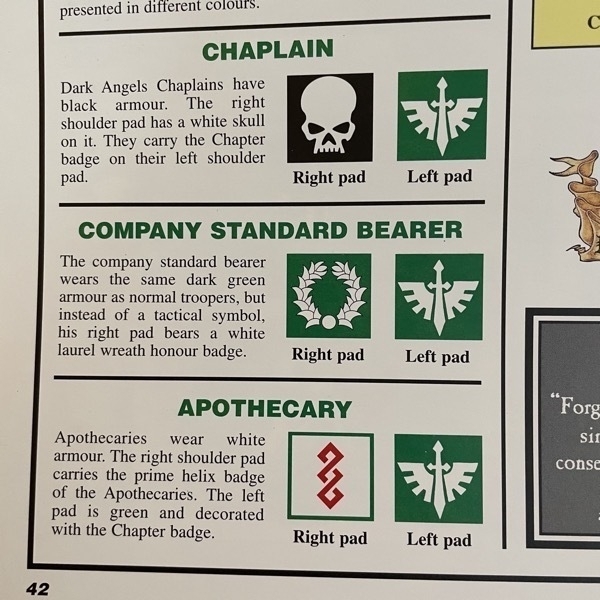 Character markings, 2nd Edition Codex: Angels of Death.
Character markings, 2nd Edition Codex: Angels of Death.HQ
Captains (Masters) typically have an imperial eagle on their right shoulder, Dark Angels symbol on their left. The right might be an angel, though (as seen on the Lazarus kit, for example), or some personal heraldry (Sammael). The captain of companies 3–9 will have his company’s heraldic symbol on his left kneepad or maybe on a tilting plate or elsewhere. One Master per company.
Lieutenants should have a red sword on their right shoulder, the appropriate Dark Angels symbol on their left shoulder. This includes the Strikemaster and the Talonmaster. Your company should have at most two Lts (though potentially one guy could have a set of Mk X eveningwear and a Phobos suit to wear for daytime fighting). (Source here is little bit shaky. The Dark Imperium box included two Lieutenants and its transfer sheet had two red swords. The GW studio Dark Angels Primaris Lt model has a red sword on his shoulder.) A mark of personal heraldry would be an acceptable alternative.
Chaplains have a skull on their right shoulder (over a black field generally but it’s fine to paint it green) and a Dark Angels symbol on their left.
While chaplains are organized under the Reclusium, each company has one chaplain assigned to it who oversees the spiritual needs of its battle brothers. Indeed, a chaplain has been listed as part of its company since Codex: Angels of Death (1996) (p36). Games Workshop’s studio model of the Ravenwing Chaplain has his right shoulder pad black with a Ravenwing badge, so it’s reasonable to deduce that if a chaplain is assigned to a company, he wear his company’s colors (though an unassigned chaplain would wear green).
So, if it’s a Chaplain in Terminator Armour, he’s the 1st Company’s Chaplain, so his right shoulder should be bone white with a red Deathwing symbol and his left should have a Crux Terminatus. If it’s a Chaplain on Bike, his right shoulder should be black with a white Ravenwing symbol and his left would be black with a skull symbol.
(I will note that only some editions of Codex: Dark Angels explicitly show a chaplain in the 1st company’s complement. Whether this is an oversight or an intentional declaration that the 1st company doesn’t have its own chaplain is up to you. In my mind, a company chaplain has a specific role in guiding and advising his battle brothers. I don’t know why the 1st company wouldn’t have a place for this. An Interrogator-Chaplain has a different job entirely.)
Librarians have a horned skull on their right shoulder (over a blue field) and a Dark Angels symbol on their left. If he’s wearing Terminator Armour, it’s a green right shoulder with a DA symbol and a crux on the left.
Apothecaries have a helix on their right, DA symbol on left, and their company’s symbol on their right kneepad. Here’s a piece I did on apothecary armor colors.
Techmarines have a cog on their right shoulder, DA symbol on the left. Tip: There’s a DA-specific cog and head on the Ravenwing accessory sprue.
Elites
Ancients should have a laurel wreath on their right shoulder, DA symbol on their left. There’s a pad for this in the Company Veterans box.
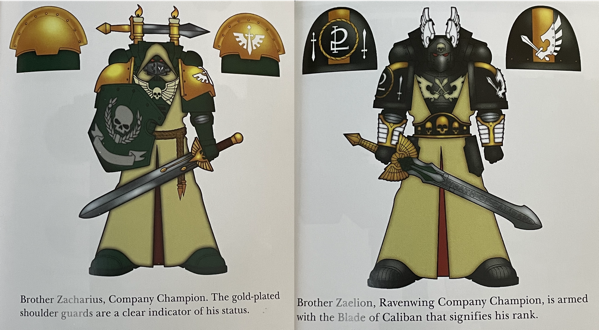 Codex: Dark Angels, six edition
Codex: Dark Angels, six editionCompany Champions have a special shoulder pad that comes in some of the command squad boxes. There isn’t a clear symbol or badge for the position.
There’s no consistent guidance on what a Champion should have. Some of GW’s studio models have a wreath, but DA definitely use that symbol for their Ancients. This piece shows a laurel wreath surrounding a skull. 🤷🏻♂️ I painted the 4th company’s checkerboard device on the right shoulder of mine.
Veterans in previous editions were marked with a red sword. Now that the Lieutenant has taken over this symbol, there hasn’t been updated guidance on how to mark up a veteran. My recommendation would be a white or silver sword, which is supported by the Company Veterans box art. This is sort of moot because there’s not a big reason to take Company Veterans or Veteran Intercessors, but this is still unresolved. Also, various editions of the codex differ on whether it should point up or down.
Bladeguard Veterans, Sternguard Veterans, and Vangaurd Veterans should have a Crux Terminatus on their right shoulder and a Deathwing logo on their left shoulder. There are crux transfers on the Indomitus and Leviathan sheets.
Deathwing Terminators should have a Deathwing symbol on their right shoulders, Crux Terminatus on their left.
Deathwing Knights have fancy Dark Angels on their right shoulders, Crux Terminatus on their left, and elsewhere (knee, tilting plate, wherever), a squad-specific pattern, typically a Quartering in some combination of red, green, bone, black, or white. Both shoulders have a thin green line tracing the borders.
Black Knights have gold pale over black on their shoulders. The right shoulder has a squad number, the left is a Ravenwing symbol. (“Fun” fact: Each Space Marine company has a traditional heraldic pattern and color. A gold pale is the 2nd company’s in many chapters. Dark Angels follow these loosely. You can see more examples here.)
Squads
Sergeants are not picked out in a conspicuous way as in other chapters that change the helmet color or add a stripe. A general Space Marine convention, though, is that sergeants have skulls on their helmets. You can also use the sword helmet from the upgrade sprues, or model your squads so that the sgt doesn’t have a helmet on to make him more obvious. For firstborn squads, the robed figures from the honor guard set make great sergeants.
Deathwing Terminator Squads
Deathwing squads aren’t explicitly numbered. Remember that their chapter badge goes on their right shoulder, the Crux Terminators on the left.
Ravenwing Squads
The Ravenwing is organized in a way that matches a previous edition’s concept of formations. There are two types of Ravenwing squads.
Attack Squads should have a gothic 1–5 on their right shoulder and a Ravenwing symbol on their left. They are composed of ten marines: six bikers, 1 attack bike, 1 Land Speeder (or Typhoon or Tornado variant). In the fluff these squads would be training and hunting together. All 10 marines would have the same number on their shoulder.
Squads 6–10 are Support Squads. They’ll consist of a squad of attack bikes or land speeders and a Land Speeder Vengeance or a Darkshroud.
Unresolved is how to mark up squads of Primaris Ravenwing marines, but I’ll make an argument for 1–2 Outrider squads, 1 ATV, 1 Storm Speeder for Attack Squads, and squads of ATVs in Support Squads with a Storm Speeder and/or the other heavy speeder types.
Nephilim Jetfighters and Dark Talons are flown by Ravenwing pilots, not Techmarines. if you want to put a decal on their right shoulder, squads 2 and 3 typically supply the pilots.
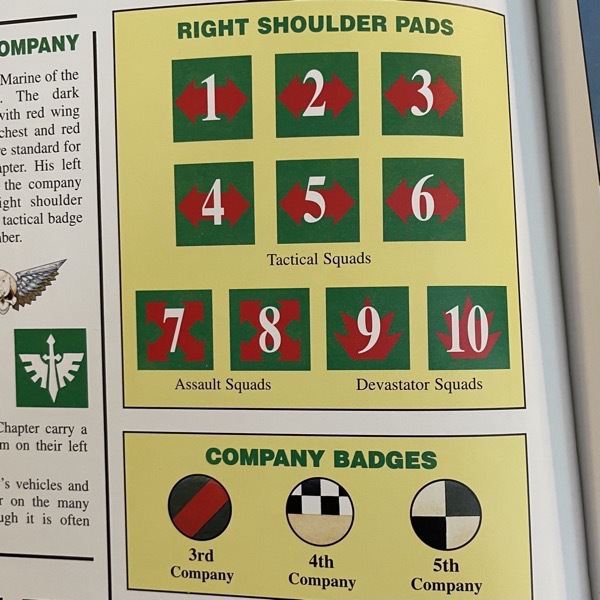 Battle company squad markings
Battle company squad markingsBattleline Squads
Page 16 of the 9th edition Codex: Space Marines breaks down squads into three types. These squads are part of the battleline:
- Tactical Squads
- Intercessor Squads
- Infiltrator Squads
- Heavy Intercessor Squads
They should have a two-headed arrow on their right shoulder pads, a Dark Angels symbol on their left. Superimposed over the arrow should be the squad number, which should be 1–6. If you have more than 60 (!) of these, you should mark the extras as being from the 6th or 7th reserve company on their left kneepads. (The 6th and 7th would have squads running up to 10.)
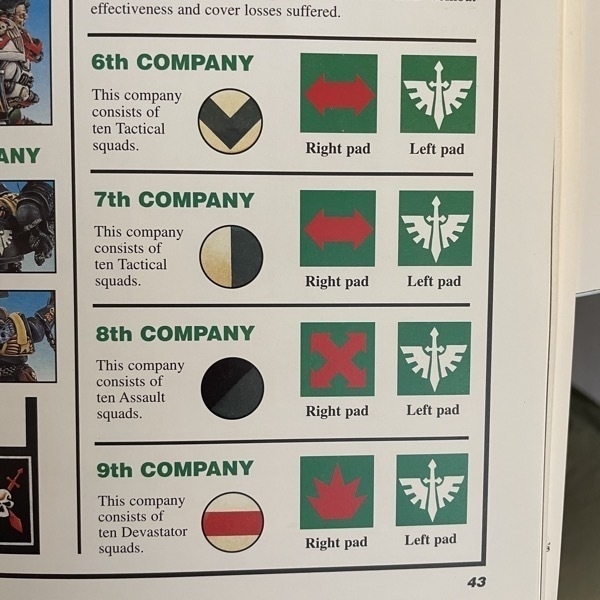 Reserve companies
Reserve companiesClose Support Squads
These squads should have a four-headed arrow on their right shoulder, a Dark Angels symbol on their left:
- Assault Intercessor Squads
- Assault Squads
- Centurion Assault Squads
- Inceptor Squads
- Incursor Squads
- Reiver Squads
Their squad number should be 7 or 8. If you have more than 20 of these marines, mark the extras as 8th company.
Fire Support Squads
These squads should have a blast symbol on their right shoulder, a Dark Angels symbol on their left:
- Aggressor Squads
- Centurion Devastator Squads
- Devastator Squads
- Eliminator Squads
- Eradicator Squads
- Hellblaster Squads
- Infernus Squads
- Suppressor Squads
- Desolation Squads
Their squad number should be 9 and 10. Reserves go in the 9th company.
Also, from page 22 of C:SM:
Even the squads themselves can be broken down to fight in a variety of roles should their captain require it. Should three brothers be detached from their fire support squad to form an Eliminator Squad, the remaining seven can form a Hellblaster Squad, pilot Invictor Warsuits, or fulfill a number of other roles.
So as with the Ravenwing having mixed squadrons, your 9th squad might be 3 Eliminators, 6 Aggressors, and an Invictor, all with a 9 on their shoulders.
Combat Squads
It’s fashionable these days to field squads of five, not ten. Two squads of five Intercessors would still all be part of, let’s say, squad 1, they’re just operating as two demi-squads. As such, all ten might have a “1” on their shoulder. One would be led by the squad’s sergeant, the other by a designated squad leader. In-game both are sergeants. Personally I give the proper sergeants an ornament on their backpacks and usually model them without a helmet, while the squad leader gets a helmet with a sword or skull on it. None of this matters in-game, it’s just a bit of flavor I try to sprinkle in.
I’ll update this guide as needed, or if I’ve gotten any of this wrong. One last note: my general feeling is that if you’re playing a pre-made army like Dark Angels, part of the fun is trying to be “correct” with all of this, but they’re your models so do whatever you think looks good! Even better, make your own custom succesor chapter and make up your own rules for how and why your chapter does what it does.
Here’s a quick infographic with some of these.
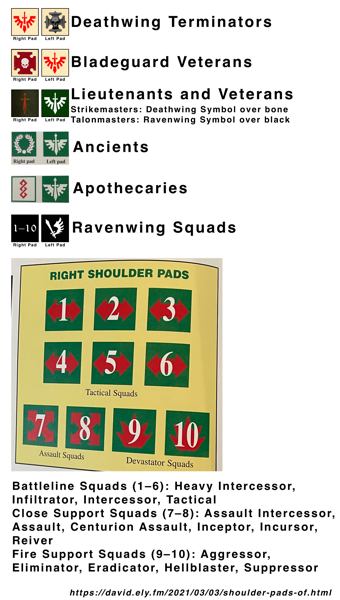
Version history:
- 3 Mar ’21: published.
- 19 Jan ’24: updated for 10e.
- 24 Jan ’24: added Infernus squads to fire support.
- 7 Feb ’24: added citations for Chaplain shoulder pad colors.
- 11 Dec ’24: added not that not all version of the codex show a 1st company chaplain.
More in this series:
- Shoulder Pads of the Dark Angels
- Dark Angels Apothecaries
- Why the Dark Angels Really Changed from Black to Green?
- How the Dark Angels story developed, from Rogue Trader to 2nd edition
- Successor Chapters
- My 4th company, “The Feared”
- The Deathwing: History and Complement
- Dark Angels Decals: A Look at Waterslide Transfer Sheets
-
Having been an 80s Nick at Nite viewer, I feel like WandaVision was made just for me. I’m looking forward to watching the third episode tonight.
It happens I met Tom King at Victory Comics just before Covid-19 restrictions started. He kindly signed my copy of Vision.
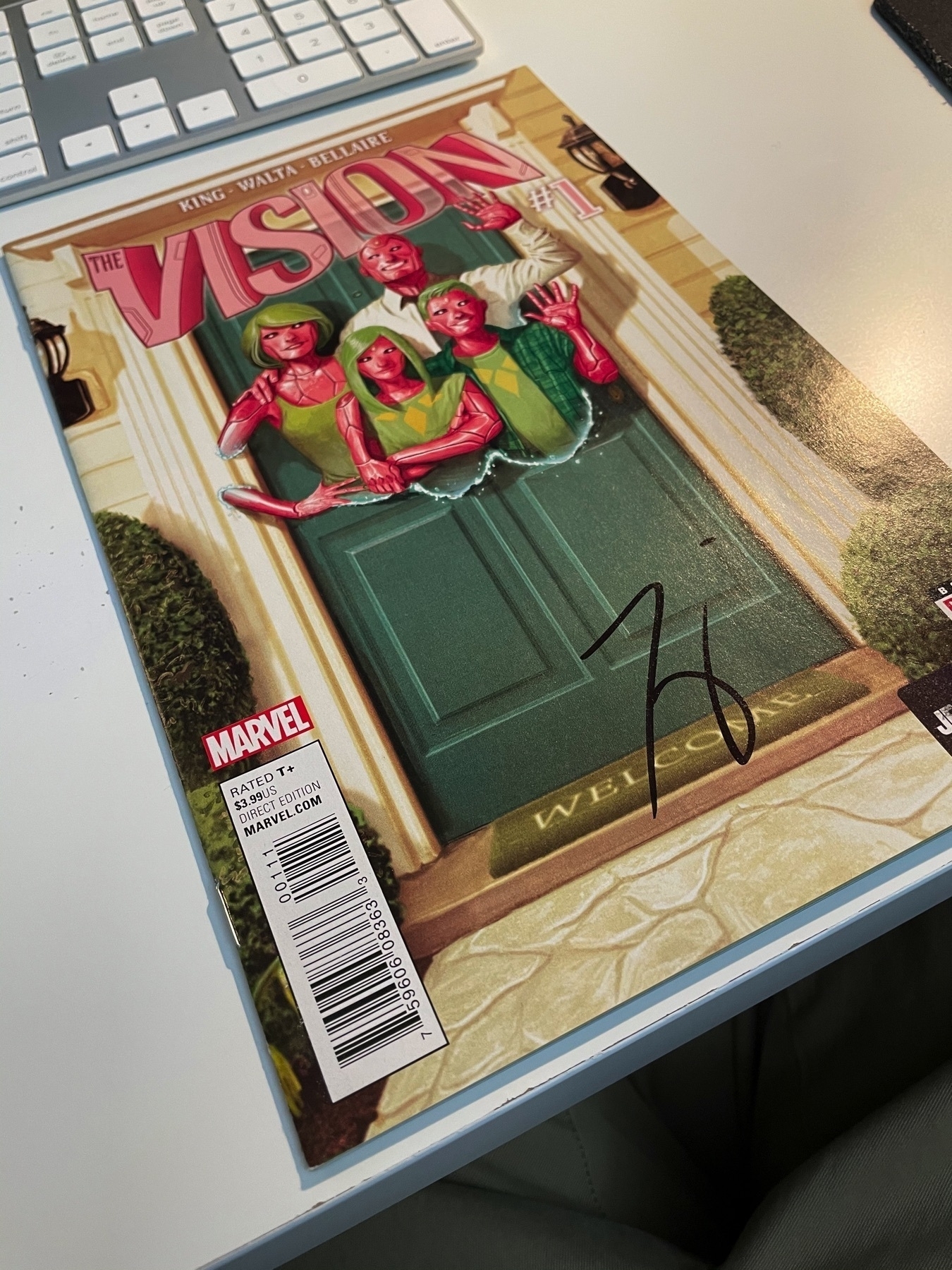
-
Wallachia 2.0.3
Release notes
- iPad keyboard shortcuts: Use the “[“ and “]” keys to move back/forward a page. ⌘-T shows the Table of Contents. ⌘-W closes the Table of Contents, if open, or closes the book.
- Fixed a bug where the application badge count didn’t reset to zero after a new chapter notification is received.
- Removed the “What’s New” page since 2.0 has been out for a while.
App Privacy
The Wallachia app does not collect any information about you. It doesn’t track you. It contains no third-party code.

-
Chapter fifteen of Wallachia should be out tomorrow. I’ve said before that one of the hardest parts of getting a chapter ready is thinking up the reader poll question. When I started this project, I pictured the polls working in a few different ways. One, they’d be a way to get me out of a jam. If I couldn’t decide on which direction to take the story, I’d have the readers vote. Fun! Two, they’d keep me on my toes, forcing me to never write too far ahead, since upcoming events would depend on how the votes went.
Naturally I expected that sometimes there would be things I wouldn’t want to put up to a vote. The story is planned out all the way to the end. There’s stuff I don’t know yet—that’s what writing is—but the big stuff, I know. So whenever I get to the end of a chapter, I usually know where the next ones are going, at least generally. Chapter sixteen, for example, doesn’t have a lot of action in it. There’s just some stuff that happens in it that follows from where we’ve been and sets up where we’re going. It’s not like it has a place where you get to vote which character dies.
As I was writing fifteen, though, I came up with something great. It was going to end on a cliffhanger. A decision was going to be put before a character, and you, the reader, were going to vote on what that character decided. The consequences would matter and really would change a few things about what’s coming up. But then as I was writing it, I realized that one of the parties involved in that decision had *absolutely no motivation*—no reason to be in the situation I was setting up. I agonized over it. I sketched out the scene longhand. I typed it, deleted it, rewrote it, and ultimately just couldn’t make it work. So I scrapped it and rewrote the whole thing, which left me—again—with no idea what to put up for the reader poll.
If this were a different book, maybe I’d have every chapter end on a big cliffhanger for you to vote on, but it’s not. I’ve said before how I think often about what Stephen King says about how you have to let the story tell itself. It’s in charge, not you. So for me, that means pacing around the house for the better part of a day trying to clear my mind until the answer comes to me—which I liked doing more when I had the house to myself and not a whole quarantined family trying to get their own stuff done. Alas.
-
Christmas Playlist ’20
I’ve been carefully building a Christmas playlist for over a decade, adding one track a year. There are now nineteen songs on the list.
- “Christmas (Baby Please Come Home)” by Darlene Love
- “Hallelujah” by Jeff Buckley
- “The Fairytale of New York” by The Pogues
- “Have Yourself a Merry Little Christmas” by Judy Garland
- “Rockin’ Around the Christmas Tree” by Brenda Lee
- “A Holly Jolly Christmas” by Burl Ives
- “White Christmas” by Bing Crosby
- “Let It Snow! Let It Snow! Let It Snow!” By Dean Martin
- “Christmas Time is Here (Instrumental)” by Vince Guaraldi Trio
- “The Christmas Song” by Nat “King” Cole
- “Sleigh Ride” by Leroy Anderson
- “Happy Xmas (War is Over)” by John Lennon
- “I Wish It Could be Christmas Everyday” by Wizzard
- “Here Comes Santa Claus” by Elvis Presley
- “What Christmas Means to Me” by Stevie Wonder
- “All I Want For Christmas is You” by Mariah Carey
- “What a Wonderful World” by Joey Ramone
- “Peace On Earth/Little Drummer Boy” by David Bowie & Bing Crosby
- “Father Christmas” by The Kinks
- “Merry Xmas Everybody” by Slade
This year’s addition is “Rockin’ Around the Christmas Tree.” It’s been a long time since this playlist moved from “here are some cool Christmas songs” to “here’s this year’s standard,” but so be it. My goal is just to pick my favorite Christmas songs, and every time I come across a new one, I add it to a list, but year after year a classic song beats the newer additions onto the list.
-
Finished up Queen’s Gambit tonight. 👍🏻
-
This week’s DuckTales has a bit where Uncle Scrooge, Della, and Louie are caught in a gravity trap. Scrooge calls them “ancient Rosa Runes,” a reference Dona Rosa’s Eisner Award-winning A Matter of Some Gravity.
-
Very small application update coming to the App Store today.
In previous versions, fi you had the table of contents page open and tapped the chapter you were currently reading, the table of contents would close and take you back to the page you were reading. Now, it takes you back to the first page of the chapter. If you want to stay on your current page, the “Resume” button at the top of the screen will do that. I like this behavior better because it gives you a quick way to go back to the start of a chapter if you do want to.
Toggling the buttons when you tap the screen should be speedier now.
Changed the way notifications are handled by the system.
-
A few thoughts on yesterday’s Apple event.
The iPhone has now reached a point, I think, where it’s an established platform and its updates aren’t “run out and get it day one” essential any longer. This is a good thing. New innovations will come, but the phone is much more a reliable tool rather than a shiny gadget at this point.
The speed of the A14 is sort of interesting. A 5nm chip in a telephone is bonkers, but it seems like a lot of that speed is being used only in ways you don’t really ever appreciate. All the computational photography is impressive, but Apple has managed to make it all happen in the background to such a degree that you don’t really ever realize or appreciate what’s going on under the hood. And on the iPad side, the lack of advanced software means I don’t have many opportunities to take advantage of the processor power I do have. How much faster would my iPad transcode video than my Mac if I could run Handbrake on it?
MagSafe looks like a handy upgrade to Qi charging. If you plug it into a larger brick, it seems like it’ll charge a good bit faster, too (though in practice I always just charge my phone at night so charging speed is rarely relevant). I’ll probably get one of the duo chargers for my bed stand and might get another to keep in my travel bag. (Travel tip: For everything you can, get a redundant copy and just keep it in your bag. You’re less likely to forget it when you’re packing if it never leaves your travel kit. Travel tip 2: On the topic of charging speed, getting a 20W charger for fast fill-ups for your travel bag is nice for when you’re not on your normal routine or need to share chargers with family.)
The magnetic wallet is interesting, but presumably you have to detach it whenever you wirelessly charge the phone, which sort of diminishes the “keep everything in one handy place” idea. Obviously it’s only for people who can get away with carrying just 2–3 cards.
I had to laugh at Apple trying to pass off League of Legends as an innovation on iPhone. As a graphics showcase, the game is over ten years old, and a MOBA with onscreen controls is terrible fit for touch.
My current AT&T plan won’t give me access to 5G. Moving to one of their unlimited plans—which I don’t need, data quota-wise, even in months when I do leave the house—would cost me something like $25/month.
HomePod Mini looks great. I have an original HomePod and like it a lot. It wasn’t cheap but it sounds fantastic, and does exactly what I want, which is to play music when I ask it to with the added ability to pick songs directly from my phone. Echo and Google Home obviously do this for much cheaper, but I really don’t trust those companies. Even after the story about Apple keeping Siri recordings, I still prefer their stance on privacy over the competition.
-
Wallachia 2.0
A new version of the Wallachia app should be in the App Store shortly. It requires iOS 14, but the previous version should keep working fine until you upgrade. 🤞🏻
Before I run down the features, I want to thank everyone who’s been reading and supporting me this past year. It’s been a ton of work but it’s been incredibly fulfilling. With this version finished, I’m looking forward to getting back to writing. (Though I’m sure there will be some bug fixes to do.)
New in 2.0, roughly in order of importance:
🎧Audiobooks have been removed from the app. This removes a lot of programming complexity for me. I don’t think a ton of people were using the audiobooks in the app, but if you subscribe to the podcast you’ll get the audio chapters the same day the prose versions go up.
📚The app now includes a library of “Essential Vampire Classics“: Lord Byron’s fragment of a novel, John William Polidori’s The Vampyre, J. Sheridan Le Fanu’s Carmilla, and Bram Stoker’s Dracula. There are many more pre-Dracula stories I could include, but this will get you started.
The books are from Project Gutenberg with a lot of formatting applied. I think they look fantastic but please let me know if you run across, say, a Latin word that hasn’t been italicized or a paragraph that’s not indented.
🆕Serialized classics. Starting with Carmilla, I’ll be releasing new chapters of classic books every week (assuming I can keep that schedule). Carmilla will run for a few months, then I’ll set up a new one.
🔔Notifications can be configured per-book. If you grant access to the app, you’ll see a bell icon in the toolbar for each book. You won’t get notified for books you haven’t opened, and you can turn them off for any book you don’t want notifications for using that icon.
🔢Handy page counter. Ebook readers tend to have a way to tell you how many pages are left in your current chapter. The trick was designing a way to show this without resorting to junking up the page with a progress bar. I reached out to Cat City Creative for some help designing ornaments for the page and we settled on a nice solution. The bottom-right page corner now features a little design that incorporates a countdown showing you how many pages are left in the chapter.
🏛Front matter pages are now properly numbered using roman numerals, and the book’s regular page numbers start with one after the front matter ends.
Elsewhere, every single page has been redesigned in some way or another, though you may not notice. The landscape view on iPhones has been streamlined to give you an extra couple of lines of text per page. The tables of contents are popovers again. The reader poll pages should work more reliably now (I hope—these are hard to test).
Under the hood, the entire app is now written using SwiftUI. I did decide to move to a simple fade animation for page turns rather than the skeuomorphic page flip the old version had. Part of this was necessity. The animation was provided by
UIPageViewControllerbut I didn’t want to embed that, and partly also I think this is just cleaner.Somewhere on my to-do list is the idea of doing a two-page view for landscape iPads, but it’s honestly not a high priority. I’d like to do some more work to speed up the layout/typesetting process, but it’s improved over version one at least.
-
Apple Music Hits is doing a block of songs about cars. They just played “The Passenger” and I thought, “lol, that song’s not about a car, it’s about heroin. The passenger is the addict.” Then I looked up the lyrics and… it really just might be a song about riding in a car.
subscribe via RSS
